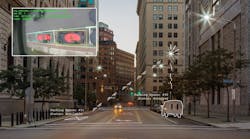As the IoT establishes itself as the next adaptation in hardware and software applications, CHUCK PICCIRILLO outlines how enabling technology and lighting providers must shift to a new conceptual and development model to ensure their businesses will thrive in the connected spaces market.
The Internet of Things (IoT) and lighting have been living in separate worlds until very recently. Over the past decade, indoor lighting has evolved from traditional incandescent and fluorescent technology into solid-state lighting (SSL) and subsequently connected lighting management systems. Simultaneously, the IoT has established itself as the next technology revolution destined to create a plethora of smart applications that will change the way we work, play, and live. As the number of connected devices reaches an all-time high, these two worlds are coming together in a way that is mutuallybeneficial.
Lighting is ubiquitous — it’s in every space within a building. It is the perfect conduit for collecting information on what is happening in a building at any given time, because it is ideally located in the space and is connected to a power source. Sensors embedded in luminaires transform light points into data nodes on the lighting network, creating the enabling technology infrastructure for smart building applications and the IoT. As more emphasis is placed on connected spaces, an increasing number of use cases become possible.
This opportunity spawns several questions. What is driving the adoption of smart lighting and IoT? What will the ecosystem look like that moves this market forward? What factors should be considered when choosing a networked lighting control system, and what are the first steps to get started?
Commercial offices benefit from a data-driven approach to controlling smart buildings enhanced with the IoT for improved occupant comfort and productivity, as well as increased energy efficiency and space utilization insights.
Smart lighting and the IoT ecosystem
A complete end-to-end IoT solution requires a lot of capabilities, and no one entity can provide this on its own. In reality, IoT solutions will be based on the latest innovations and technologies as well as partnerships and alliances, where each organization contributes its own area of expertise to form a complete solution.
Partnerships are emerging between lighting companies and other technology-based companies — many of which were unlikely before this latest technology revolution. Although still in its infancy, many lighting companies are teaming up with traditional IT organizations, software service providers, and, in many cases, other lighting companies to tackle new and innovativeapplications.
For example, lighting companies need a cloud infrastructure to store data collected about the space and are forming partnerships with companies like Amazon, Microsoft, Google, etc., which can provide services that connect lighting networks to the cloud.
This begs the question: What do you do with the information that is coming from the lighting network? Software-as-a-service (SaaS) companies are taking information to produce the applications and analytics that are needed for particular smart IoT use cases. Since lighting is everywhere, each light point can provide very accurate data about a specific space within a building and this level of accuracy enhances the analytics capability that SaaS applications require. They can gain granular insights from lighting system data about what is happening in the space.
“Coopetition” in the market is increasing. Lighting manufacturers are seeking out other lighting manufacturers to go to market together with solutions that are mutually beneficial. In this new blended world, previous competitors are now seeing the value of combining products and expertise.
Drivers for adoption of smart lighting
As previously mentioned, lighting is ubiquitous and well-suited for collecting information about activities taking place in a building at any given time. With this as its backdrop, there are other major factors leading to the adoption of smart lighting systems.
Energy and operational savings. According to IBM, the day-to-day operation of a building represents more than 70% of the total cost of that building over its lifespan — this includes things like electricity, heating and cooling, water, etc. The immediate impact of IoT in commercial buildings is to lower operational costs, particularly in the form of energy savings. And many building codes, especially in the United States, are being rewritten to address these new cost reduction requirements, another factor driving adoption.
Building efficiencies. By creating a digital version of a building and its internal operations including systems and occupant activities, you can visualize what happens in the building on a day-to-day basis and use those insights to make better decisions. These reports enable facility executives to improve efficiencies while they centrally manage systems in the building or group ofbuildings.
Occupant health and wellbeing. There has been a shift in recent years toward occupant health and wellbeing and the impact that factors like lighting and room temperature have on productivity and alertness levels. With this in mind, many companies are piloting applications that test how these factors impact their employees’ experiences while at work.
Considerations for IoT deployment
Selecting an infrastructure that will support IoT can be an overwhelming task. There are still many unknowns about what the exact requirements will be, and no one wants to make an investment mistake. However, there a few key considerations when choosing an intelligent lighting system infrastructure as a platform for IoT, which can help future-proof the system.
Be prepared to scale. Choose a software-based, scalable infrastructure that can grow in size and scope, protecting and extending the value of your investment. Software is easy and cost effective to upgrade, and you will not need to rip out and replace expensive hardware as you grow or adjust your space.
Stay flexible and agile. Choose an infrastructure that not only supports change but handles it quickly. Most office space is reconfigured regularly to accommodate employee movement and space adjustments. Chances are you will need to adjust lighting and other smart building applications. You’ll want to manage luminaires and control zones quickly with a few mouse clicks and without rewiring or moving fixtures. And individual addressability of each luminaire will enable you to capture the granular data needed for applications such as predictivemaintenance.
Go wireless. Wireless technology has improved drastically over the past five years and it will continue to improve moving forward. In the not-so-distant future, virtually everything will communicate wirelessly including emerging IoT applications that will make your smart building even smarter, so be prepared. The initial technical challenges of deploying wireless have been overcome and now wireless is the connectivity of choice because it costs less to install, is more flexible in retrofit spaces than hard-wired systems, and can be deployed quickly.
Stick with non-proprietary technology.A standards-based, non-proprietary platform is key to enabling the variety and number of potential IoT applications that will surface, including those from startups. Access to a broad ecosystem fundamentally conflicts with a proprietary platform strategy. You don’t want your options to be limited as you roll out specific IoT applications. Your system should have the ability to connect to a range of devices from multiple manufacturers. Pick a solution that allows you to select the right hardware for the space, without being beholden to a specificmanufacturer.
The platform needs to connect to the cloud for data storage and SaaS-based applications such as space utilization, asset tracking, conference room and desk bookings, and more. Open, cloud-connected platforms enable more developers to deliver more innovative apps quickly and cost-effectively.
Streamline the user experience. Choose a system that is easy-to-use for both the facility manager and occupants. Additional features and functionality should not translate to additional complexity for facility managers and their operations team. As smart systems evolve, facility managers will be putting more control of the environment into the hands of occupants to support their preferences in their workspaces. A simple user experience is crucial to making the facility team’s tasksmanageable.
Put IoT potential to work
IoT brings smart lighting to the next level. Think of it as smart lighting on steroids. While smart lighting brings efficiencies and automation to the lighting system, the addition of IoT tells a broader story about the space, the occupants, and the building itself.
Like any new technology wave, there will be those who take a cautious, slow-roll approach, while early adopters want it deployed everywhere as soon as possible. As the industry grows and matures, more pilots are being deployed to ensure the products of all suppliers involved in an IoT system are compatible for seamlessoperation.
It depends on the use case, but some pilots can run in as few as two weeks, while a more typical pilot period lasts approximately six months, with many choosing a phased approach versus a full deployment. Once deployed, and depending upon the type of application, the return on investment may be immediate or not too far off in the future.
As the IoT and smart lighting worlds continue to merge, the ecosystem of lighting manufacturers and software providers will continue to expand, bringing unique applications to market that have yet to be imagined. The promise of a new intelligent world is a reality and it starts with smart lighting.
CHUCK PICCIRILLO is head of product – Lighting Networks & Services for Osram. A 19-year veteran of the Osram organization, Piccirillo has served in engineering roles, both managing projects and delivering manufacturing solutions, and later moved into product marketing and business development roles with Osram. He participated in a pre-engineering program with Saint Bonaventure University, received a BS in chemical engineering from Clarkson University, and completed an MBA program with a focus on high tech at the D'Amore-McKim School of Business at Northeastern University. Piccirillo is a member of the Illuminating Engineering Society of North America (IESNA) and is Lighting Certified.



![An installer uses a cell phone to configure a connected lighting system in a Next Generation Lighting Systems (NGLS) living lab. [Photo credit: Image courtesy of Pacific Northwest National Laboratory (PNNL) and NGLS.] An installer uses a cell phone to configure a connected lighting system in a Next Generation Lighting Systems (NGLS) living lab. [Photo credit: Image courtesy of Pacific Northwest National Laboratory (PNNL) and NGLS.]](https://img.ledsmagazine.com/files/base/ebm/leds/image/2020/06/NGLS_Photo_2.5ed693de53fa2.png?auto=format,compress&fit=crop&q=45&h=139&height=139&w=250&width=250)


